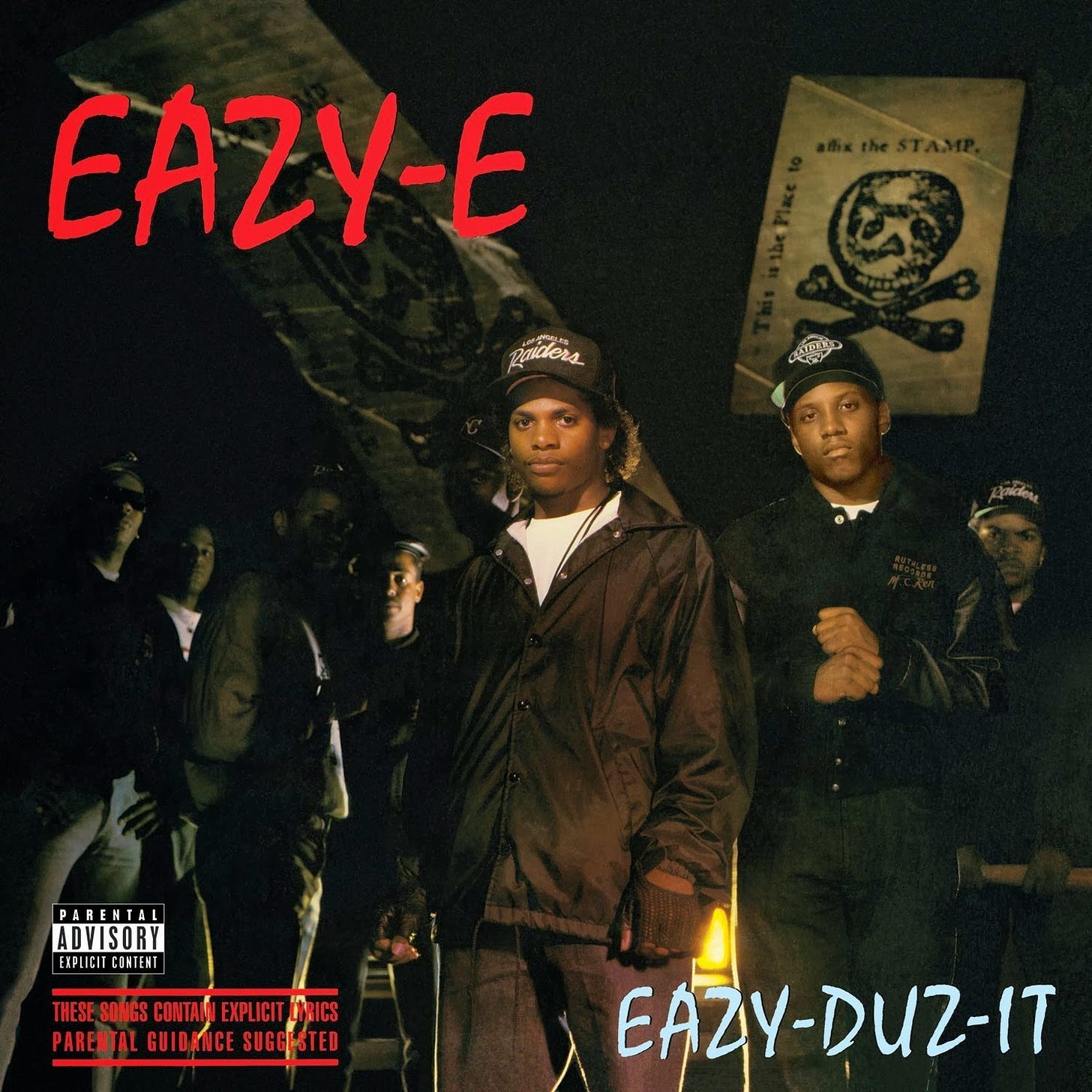Retrospective Review: Eazy-Duz-It by Eazy-E
Hate him or love him, Eazy-E cemented himself with Eazy-Duz-It.
At the start of Eazy-E’s debut album, Eazy-Duz-It, a distorted and booming voice poses, “Now that you’ve purchased the album, what are you going to do with it, you b*tch?” This quote sets the tone for a loud, audacious, and amusing album. It’s a memorable beginning to an influential album that played a significant role in shaping the history of hip-hop, now celebrating thirty-five years.
Eric “Eazy-E” Wright was an authentic gangsta, regarded as one of the founding fathers of Gangsta Rap. Unlike many rappers, he lived the lifestyle he rapped about, making his money through drug dealing and other illegal activities. After realizing the dangers associated with street life, he turned to music as a legitimate source of income. He is primarily recognized for his involvement in N***az With Attitude (N.W.A.), one of the pioneering gangsta rap groups. N.W.A. included future superstars like Dr. Dre, Ice Cube, MC Ren, and DJ Yella. When their debut album, Straight Outta Compton, was released, it made a tremendous impact, hitting with the force of a semi-truck.
His rise to fame as an artist played a crucial role in setting the stage for the success of Straight Outta Compton. The initial plan for his first single, “Boyz-N-The-Hood,” written by Ice Cube and produced by Dr. Dre, was to offer it to the New York-based group H.B.O. (Homeboys Only), who were signed to Ruthless Records. However, after realizing the song didn’t align with H.B.O.’s Run-DMC-inspired style, Dre convinced Eazy to take on the rap himself.
With its distinctive tinkling keyboard line, deliberate rhythm, and heavy handclap-laden drum track, “Boyz-N-The-Hood” broke away from the traditional Los Angeles music scene at the time. The single’s immense success sold thousands of records independently, laying the foundation for Eazy’s independent label, Ruthless Records, and skyrocketed him and his colleagues to celebrity status within the Los Angeles rap community. A “remix” of the song can be found on Eazy-E’s album Eazy-Duz-It, with the sole addition being an introductory verse to set the scene.
While Straight Outta Compton undoubtedly stands as the superior album for N.W.A. as a group, with its standout moments, Eazy-Duz-It demonstrates a higher level of cohesiveness as a complete body of work. It paints a more comprehensive picture of Eazy-E as a rapper and a personality, surpassing what Straight Outta Compton achieved for N.W.A. as a collective.
From a musical perspective, Eazy-Duz-It holds more intrigue. While the tracks on Straight Outta Compton were compiled over several years, most of Eazy-Duz-It was recorded in a concentrated series of sessions. This resulted in a more unified sound, thanks to the creative efforts of Dr. Dre and DJ Yella, who incorporated innovative elements into the album. Like Straight Outta Compton’s finest tracks, Eazy-Duz-It boasts various samples convoluted and layered together, occasionally enhanced by live instrumentation.
Eazy-Duz-It is indeed known for its controversial lyrical content. The album contains explicit and provocative references to sexual assault, domestic abuse, violence, and womanizing, prevalent themes in gangsta rap during that era. Despite the extreme nature of the content, Eazy-E can pull it off by incorporating elements from raunchy comedians like Blowfly, Rudy Ray Moore/Dolemite, and Redd Foxx, who pushed the boundaries of good taste in their respective genres.
While he may not have been regarded as the greatest emcee, his performance on Eazy-Duz-It is considered his best. It is believed that he punched in nearly every line during the recording process, and later in his career, he relied on reference tracks to guide his performance. Nonetheless, he sounds comfortable and confident on the mic throughout the album.
Eazy-Duz-It can be viewed as a double album, with a clear division between the “street” and “radio” sides. Each side has its distinct flow and seamlessly transitions from one track to another. This division was a strategic move at the time, as gangsta rappers sought ways to gain airplay on mainstream radio stations. The “street” side of the album features Eazy-E delivering violent, explicit, and humorous songs. A standout track, “Still Talkin’,” with provocative lines like, “I might be a woman beater, but I’m not a pu**y eater.” However, including impressions from Coming to America, performed by Eazy-E, Ice Cube, and The D.O.C., adds an entertaining element that can still be appreciated even after three decades.
Eazy-Duz-It and Straight Outta Compton were crucial in catapulting Eazy-E and N.W.A. to mainstream recognition during the late ‘80s and early ‘90s. These albums not only captured the attention of supportive fans but also drew criticism from parent groups and even caught the scrutiny of the FBI. Eazy-E, known for his showmanship, fully embraced the attention and spectacle surrounding N.W.A.
Reflecting on the content of Eazy-Duz-It in today’s climate, it can be challenging to justify some of the themes found in the album, as with much of the gangsta rap from that era. However, it is worth noting that the album’s content is not significantly different from consuming an ultra-violent action movie from the same period. The album’s merit lies in the execution and commitment to the craft demonstrated by Eazy-E and the N.W.A. crew. Even with occasionally controversial lyrics, Eazy-Duz-It exemplifies the group’s artistic abilities.


